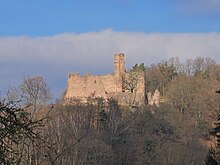Palatine main watershed
The Palatinate main watershed forms the watershed between the Upper Rhine and the Middle Rhine in the Palatinate , the two successive sections of the Rhine that touch (Upper Rhine) or flow through (Middle Rhine) the federal state of Rhineland-Palatinate .
In the southern and central Palatinate Forest , the effect of the Palatinate main watershed is particularly clear. There she separates the basins of four major drainage systems of the low mountain range in eastern and western area: the the upper reaches Wieslauter called Lauter , the Queich and Speyerbach flow east directly to the Upper Rhine, the Schwarzenbach collects the water from the western Palatinate Forest and sends it over Blies , Saar and Moselle to the Middle Rhine.
course
South and central part
In the southern Palatinate Forest, the German part of the Wasgau , the Palatinate main watershed begins on the border with France in the area of the Erlenkopf ( 473 m above sea level ), where it continues the watershed of the northern Vosges . Always oriented roughly from southwest to northeast, it first leads east past Eppenbrunn and Pirmasens over the Großer Schiffelskopf ( 457 m ) and reaches the Graefensteiner Land . From there it runs to the Hortenkopf ( 606 m ) in the Middle Franconian Pasture , where a few kilometers further with the hamlet of Johanniskreuz ( 470 m ), one of the highest settlements in the Palatinate Forest is located exactly on the Palatinate main watershed. This then reaches the area west of the local community Waldleiningen in the Lower Frankenweide .
Northern part
Two variants are possible for the further course of the Palatinate main watershed; Depending on whether the mouth of the Nahe near Bingen is still part of the Upper Rhine or the Middle Rhine, the main watershed runs south or east of the Nahe catchment area.

In the first, the mostly assumed case, the main watershed is identical to the watershed of the Schwarzbach and its tributaries (especially Moosalb , Rodalb , Wallhalb and Hornbach ) to the Nahe tributary of the Glan . The watershed runs from the Lower Franconian Pasture to the west through the Reichswald past the Great Humberg ( 430 m ) into the area of the Great Hausberg ( 471 m ) between Kaiserslautern and Landstuhl . On the Sickinger Höhe it leads near its northern edge to the Saarland border near Homburg .
In the second case, which is more seldom postulated, the main watershed from the Lower Franconian Pasture continues in a north-easterly, later more northerly direction. She separates the catchment area close to the west, to the local forest Lauter called Lauter , the Alsenz and Appel Bach , include smaller sources of the left Upper Rhine tributaries, namely Isenach , Eckbach , Eisbach and Pfrimm . From the stump forest in the northern Palatinate Forest, the main watershed changes to the North Palatinate Bergland , the highest point of which, the Donnersberg ( 686.5 m ), it passes immediately west of the summit. North of Kirchheimbolanden , near Orbis ( 327 m ), it leaves the Palatinate towards Rheinhessen between the source of the Selz , which flows to the Upper Rhine, and the upper reaches of the Nahe tributary, Wiesbach .
Altitude
In the south, the Palatinate main watershed only reaches heights of less than 500 m ; its highest points are in the central Palatinate Forest northwest of the Hortenkopf with 591 m and near Eschkopf and Mosisberg with 596 m each . The two possible branches further north differ considerably in altitude: the branch facing west is consistently well below 500 m . The north branch on the Donnersberg is more than 600 m , from there its height decreases over the last eight kilometers to the Rhine-Hessian border to just over 300 m .


